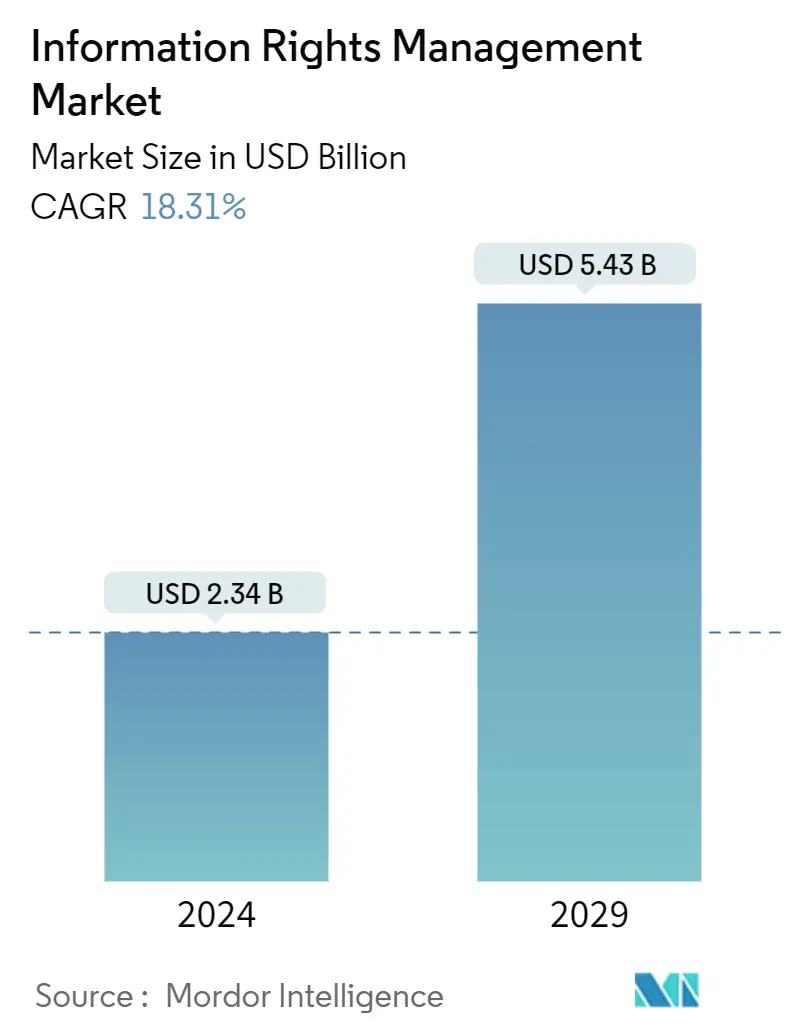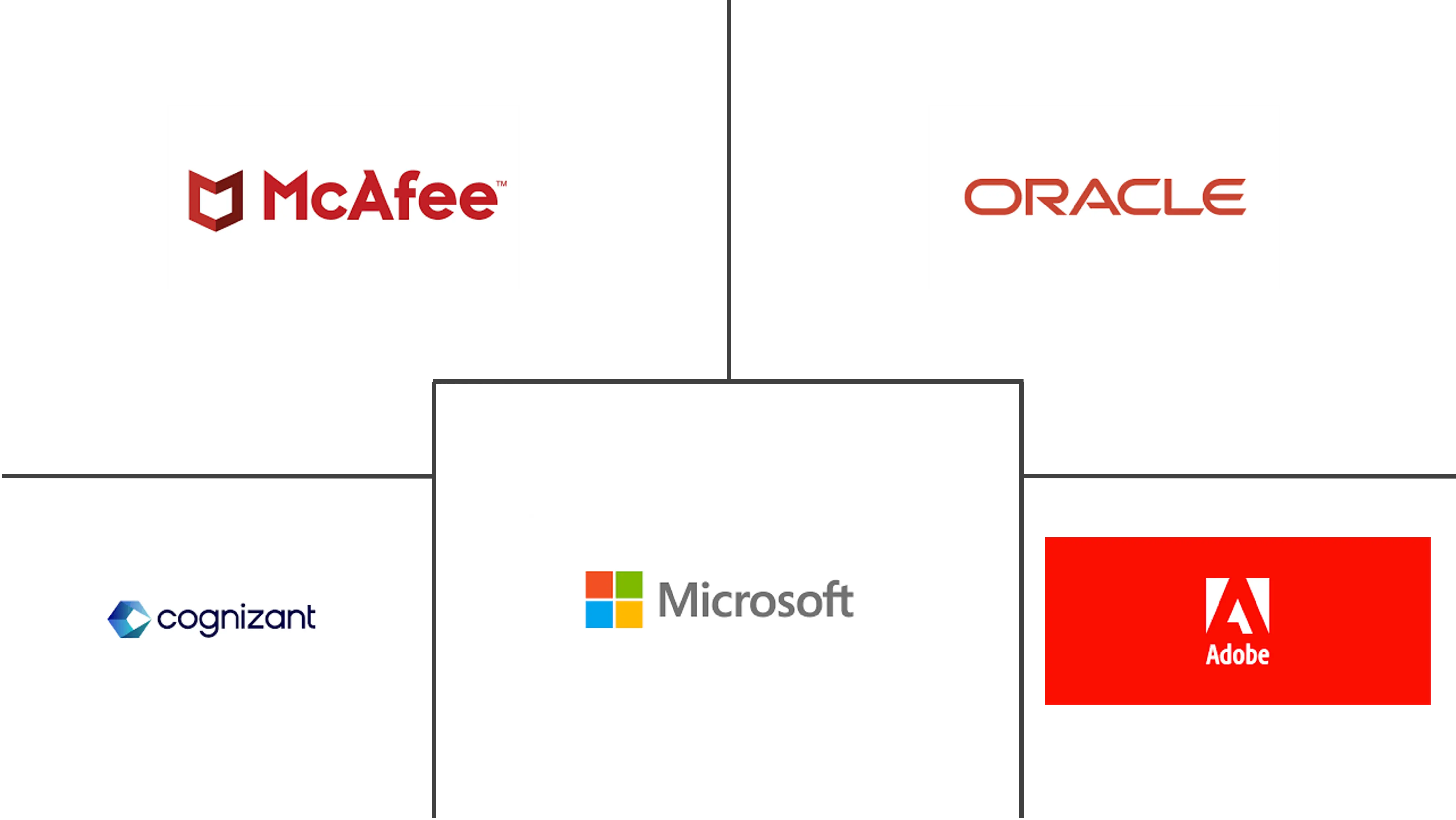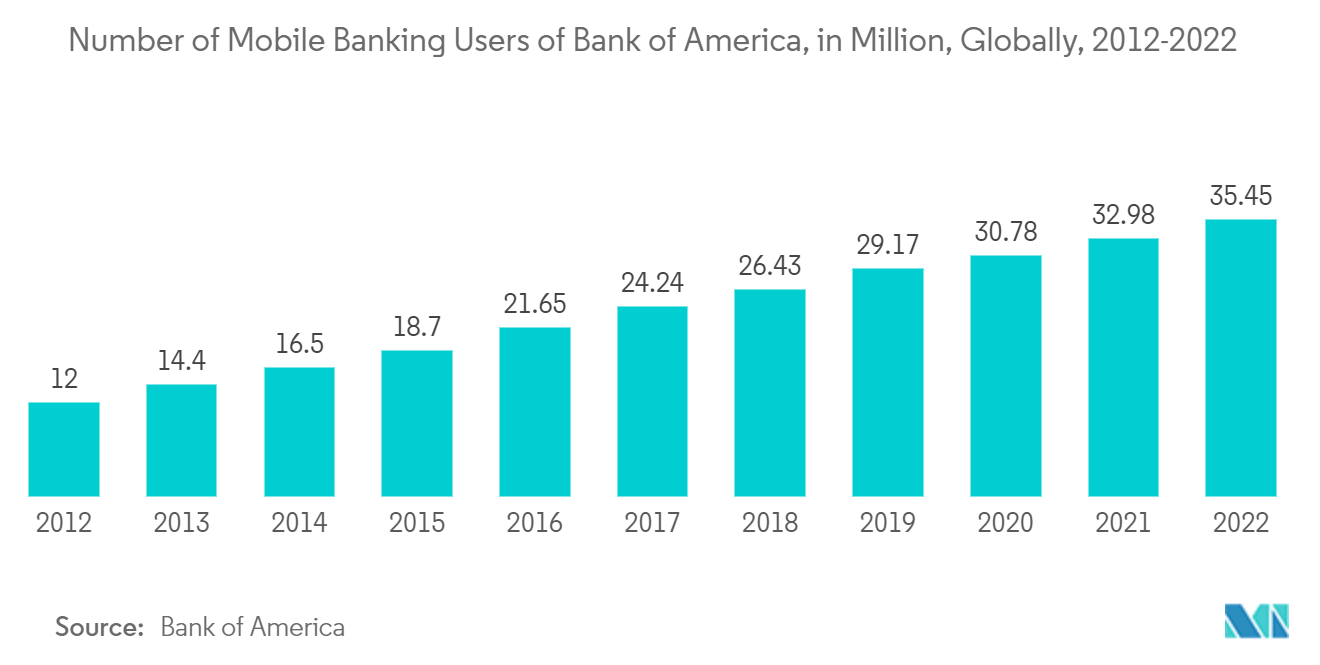Information Rights Management Market Size

| Study Period | 2019-2029 |
| Market Size (2024) | USD 2.34 Billion |
| Market Size (2029) | USD 5.43 Billion |
| CAGR (2024 - 2029) | 18.31 % |
| Fastest Growing Market | Asia Pacific |
| Largest Market | North America |
Major Players
*Disclaimer: Major Players sorted in no particular order |
Information Rights Management Market Analysis
The Information Rights Management Market size is estimated at USD 2.34 billion in 2024, and is expected to reach USD 5.43 billion by 2029, growing at a CAGR of 18.31% during the forecast period (2024-2029).
Enterprises worldwide are increasingly using online platforms to communicate their business information due to the digitalization of business processes, which need encrypted access rights for security purposes of the document, creating an opportunity for the IRM software market vendors.
- IRM frequently encrypts files to impose access controls, and extra IRM rules can be used to allow/deny specific actions after a document has been encrypted. This can result in a user only being able to view material from a document, not copy or paste it. In other circumstances, users may be prohibited by the IRM rule from printing, editing, or taking screenshots of the document. This drives the market adoption of IRM solutions because it enables a company to share information files with advanced securities.
- IRM is a subset of Digital Right Management, and companies are adopting DRM tools because, through this, digital media assets are protected by the use of an encryption program, which limits access to particular individuals, times, or devices and imposes a limit on the number of times the content can be installed or opened. DRM material is typically used by corporations to protect confidential data, especially during product design papers and M&A (merger and acquisition) processes. With efficient digital rights management software, a firm may quickly launch new campaigns and product concepts while keeping in compliance with regulatory obligations.
- It can stop competitors from obtaining trade secrets or intellectual property. Consider a pharmaceutical organization. For instance, these IRM tools may be working on a patent for a new medicine, but the absence of IRM controls may allow a rival to steal useful informations. Additionally, private information about a bank under investigation internally might be made public, harming the bank's standing in the market. This road application of IRM across various end-user industries creates a demand for market growth.
- The absence of standard practices is one of the main issues organizations face with adopting information-proper management tools. Lack of uniformity in strategy, digitization documents, automating procedures, managing the growing volume, safeguarding information access, reducing information silos, integrating with legacy systems, and removing low-quality data are common information management difficulties.
- The COVID-19 pandemic caused many worldwide to move online, accelerating a long-term digital transformation. Several people began working from home, children with at-home Internet connections started attending classes online, and numerous businesses adapted digital business models to continue operating and keep certain revenue streams. In the meantime, researchers used artificial intelligence (AI) to underastand the virus and hasten the search for a vaccine. Mobile applications were created to help "monitor and trace" the growth of the pandemic, which has increased the demand for IRM software across various end users due to an increase in the volume of online content.
Information Rights Management Market Trends
BFSI Industry is Expected to Hold Significant Share
- The banking, financial services, and insurance (BFSI) industry is most vulnerable to data loss, and due to the sensitive nature of the information, BFSI firms must be protected. Banks have various financial and personal data about their clients; anyone with access rights can access all that information. Financial technology development has produced several breakthroughs and advancements, including wire transfers, credit/debit cards, online banking, and mobile payments. Banks have had to modify their systems to suit these changes and transform their operations to ensure sustained security while introducing new technologies.
- Hence, the demand for IRM is expected to increase as it will enable banking and financial institutions to mitigate security risks and collaborate with external parties. Players such as Seclore's enterprise digital rights management (EDRM) ensure end-to-end protection of information shared within and outside the enterprise. The number of mobile banking customers is increasing. Service providers use the online medium to enable users to have services requiring confidential data specific to the customers, which need to be secured from unauthorized access, driving the market worldwide.
- Businesses seeking large loans must send the bank their private information, including financial information, business strategies, and revenue projections, for the bank to analyze credit risk. Credit analysts examine the data to calculate the optimal lending rate of interest and other loan terms. It contains extremely sensitive information about a company. Thus, any of the multiple teams managing it within the bank have the threat of a security breach, which requires IRM tools in the organization.
- Additionally, sensitive information is regularly provided to third parties, frequently without protection, in an age where outsourcing, cloud computing, bring-your-own-device (BYOD), file-sharing, and collaboration with external parties are common in conducting business. The risk of data leaking increases with the level of external engagement within the company, which creates a demand for IRM tools in the BFSIs because it would be helpful
- Due to digital transformation, several BFSI industry market players are innovating new technology to provide a high-security platform for Data, which is creating an opportunity for the IRM market. For instance, in January 2023, HDFC Bank collaborated with Microsoft on the next stage of its digital transformation journey with the goal of maximizing business value through modernizing the data landscape, transforming the application portfolio, and securing the company with Microsoft Cloud.

North America is Expected to Dominate the Market
- The consumption of digital media content and the digitization of enterprises in North America, especially in the United States, is increasing tremendously, owing to the rapid adoption of technological advancements in the region.
- The increasing speed of internet speeds, coupled with the increase in the number of devices supporting access to digital media, has increased the freedom of consumers to access media content anywhere and anytime. Such trends are expected to boost the region's dominance in adopting IRM solutions.
- Mobile internet usage in the country has grown tremendously, with the greatest number of mobile wireless connections. The use of digital rights management solutions is now essential due to the increase of tablets, smartphones, and client internet dependence. Due to the increase in wireless technology investments by businesses, there would be a greater need for IRM solutions supported by IRM market players working to present trustworthy IRM solutions in the US and Canada.
- A more stringent regulatory framework has emerged in response to the region's current trend of data hacks, and businesses are more accountable for how client data is handled. Several privacy and data protection legislation have been introduced, including HIPAA in the healthcare business and PCI DSS in the finance industry. Because IRM can track actions such as file access and distribution, it can automatically provide a thorough audit trail, enabling it to offer regulatory compliance.
- Research and development knowledge, trade secrets, and intellectual property data are vulnerable to insider threats, which include employees and other internal staff. For instance, inter-department data are confidential, and data transfer related to the financials of the company can be restricted to certain members of the organization through the IRM tool by including password protection files in e-mails, which is driving the market in the United States because many large corporates have their head offices in the region.

Information Rights Management Industry Overview
The competitive landscape of the information rights management market is fragmented owing to the presence of several IRM solution providers. The market players are extending partnerships and collaborating with several companies in different end-users to boost their market presence. The companies are also making efforts to provide innovative solutions and offerings in the market.
In September 2023 - Oracle announced its participation initiative to a new open standard on network and data security, which will help organizations to better secure their data in distributed IT environments by providing them with collective enforcement of shared security policies, enabling networks to reinforce the security architecture organizations have been using without changing existing applications and networks.
In September 2022, Microsoft developed the information rights management (IRM) elements of Microsoft 365 applications and services, which could be used after the rights management service (RMS) has been activated. The user company may begin utilizing Azure RMS to protect crucial emails and documents. This information security system could protect all file formats, which also connects with servers like Microsoft Exchange and SharePoint and client programs like Excel, Microsoft Word, and others.
Information Rights Management Market Leaders
-
Microsoft Corporation
-
McAfee, LLC
-
Cognizant Technology Solutions Corporation (assetServ)
-
Adobe Inc.
-
Oracle Corporation
*Disclaimer: Major Players sorted in no particular order

Information Rights Management Market News
- February 2023: WeTransfer, a global network for exchanging digital files, and the blockchain platform Minima announced a unique collaboration to develop information rights management solutions. The two companies partnered to implement non-fungible tokens (NFTs) on the Minima network, enabling companies worldwide to manage their intellectual property digitally.
- February 2023: Fujitsu launched a new platform, Fujitsu Web3 Acceleration Platform, to support global Web3 developers in the IT sector. This would help developers to build new applications for Web3, enabling new ways to interact, create, and share data freely and securely including digital content rights management, contracts, business transactions, and processes.
Information Rights Management Market Report - Table of Contents
1. INTRODUCTION
- 1.1 Study Assumptions and Market Definition
- 1.2 Scope of the Study
2. RESEARCH METHODOLOGY
3. EXECUTIVE SUMMARY
4. MARKET DYNAMICS
- 4.1 Market Overview
-
4.2 Market Drivers
- 4.2.1 Increasing Adoption of BYOD Trends and Enterprise Mobility, and Stringent Regulations and Compliance
- 4.2.2 Adoption of Digital Rights Management Solutions Across Various End-user Verticals
- 4.2.3 Rapid Digitization of Business Process Coupled With Increase in Internet Usage
-
4.3 Market Restraints
- 4.3.1 Lack of Standardization for Security of Digital Content
-
4.4 Industry Attractiveness - Porter's Five Forces Analysis
- 4.4.1 Bargaining Power of Suppliers
- 4.4.2 Bargaining Power of Buyers/Consumers
- 4.4.3 Threat of New Entrants
- 4.4.4 Threat of Substitute Products
- 4.4.5 Intensity of Competitive Rivalry
- 4.5 Assessment of Impact of Covid-19 on the Market
5. MARKET SEGMENTATION
-
5.1 By Size of the Organization
- 5.1.1 Small and Medium Enterprises
- 5.1.2 Large Enterprises
-
5.2 By Deployment Mode
- 5.2.1 On-Cloud
- 5.2.2 On-Premise
-
5.3 By End-user Industry
- 5.3.1 BFSI
- 5.3.2 Healthcare
- 5.3.3 Media and Entertainment
- 5.3.4 Education and Research
- 5.3.5 Government and Public Institutions
- 5.3.6 IT & Telecom
- 5.3.7 Other End-user Industries (Law and Order Agencies, Manufacturing)
-
5.4 Geography
- 5.4.1 North America
- 5.4.2 Europe
- 5.4.3 Asia Pacific
- 5.4.4 Latin America
- 5.4.5 Middle East and Africa
6. COMPETITIVE INTELLIGENCE
-
6.1 Company Profiles*
- 6.1.1 Microsoft Corporation
- 6.1.2 McAfee, LLC
- 6.1.3 Cognizant Technology Solutions Corporation (assetServ)
- 6.1.4 Adobe Inc.
- 6.1.5 Oracle Corporation
- 6.1.6 Bynder B.V.
- 6.1.7 Nextlabs, Inc.
- 6.1.8 Intralinks, Inc.
- 6.1.9 Citrix Systems, Inc.
- 6.1.10 Seclore Technology Private Limited
- 6.1.11 Locklizard Limited
- 6.1.12 Vaultize Technologies
7. INVESTMENT ANALYSIS
8. MARKET OPPORTUNITIES AND FUTURE TRENDS
** Subject To AvailablityInformation Rights Management Industry Segmentation
Information rights management (IRM) is a technology that helps enterprises secure and protect files and documents carrying confidential information. IRM technology protects documents, spreadsheets, and presentations created by enterprises and protects these files from unauthorized copying, viewing, printing, forwarding, deleting, and editing.
The information rights management market is segmented by size of the organization (small and medium enterprises, large enterprises), deployment mode (on-cloud and on-premise), end-user industry (BFSI, healthcare, media and entertainment, education and research, government and public institutions, and IT & telecom), and geography (North America, Europe, Asia Pacific, Latin America, and Middle East and Africa). The market sizes and forecasts are measured in USD for all the above segments.
| By Size of the Organization | Small and Medium Enterprises |
| Large Enterprises | |
| By Deployment Mode | On-Cloud |
| On-Premise | |
| By End-user Industry | BFSI |
| Healthcare | |
| Media and Entertainment | |
| Education and Research | |
| Government and Public Institutions | |
| IT & Telecom | |
| Other End-user Industries (Law and Order Agencies, Manufacturing) | |
| Geography | North America |
| Europe | |
| Asia Pacific | |
| Latin America | |
| Middle East and Africa |
Information Rights Management Market Research FAQs
How big is the Information Rights Management Market?
The Information Rights Management Market size is expected to reach USD 2.34 billion in 2024 and grow at a CAGR of 18.31% to reach USD 5.43 billion by 2029.
What is the current Information Rights Management Market size?
In 2024, the Information Rights Management Market size is expected to reach USD 2.34 billion.
Who are the key players in Information Rights Management Market?
Microsoft Corporation, McAfee, LLC, Cognizant Technology Solutions Corporation (assetServ), Adobe Inc. and Oracle Corporation are the major companies operating in the Information Rights Management Market.
Which is the fastest growing region in Information Rights Management Market?
Asia Pacific is estimated to grow at the highest CAGR over the forecast period (2024-2029).
Which region has the biggest share in Information Rights Management Market?
In 2024, the North America accounts for the largest market share in Information Rights Management Market.
What years does this Information Rights Management Market cover, and what was the market size in 2023?
In 2023, the Information Rights Management Market size was estimated at USD 1.91 billion. The report covers the Information Rights Management Market historical market size for years: 2019, 2020, 2021, 2022 and 2023. The report also forecasts the Information Rights Management Market size for years: 2024, 2025, 2026, 2027, 2028 and 2029.
Information Rights Management Industry Report
Statistics for the 2024 Information Rights Management market share, size and revenue growth rate, created by Mordor Intelligence™ Industry Reports. Information Rights Management analysis includes a market forecast outlook to for 2024 to 2029 and historical overview. Get a sample of this industry analysis as a free report PDF download.



